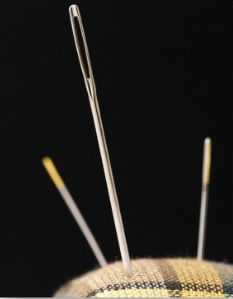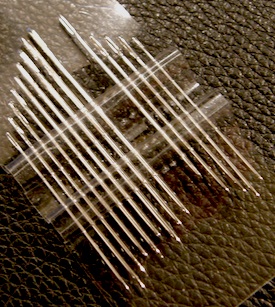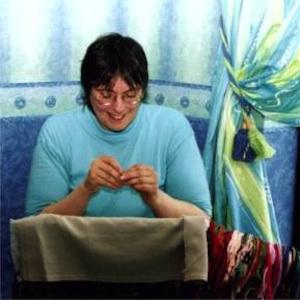- Home
- Embroidery Needles
Embroidery needles - to the point
Embroidery needles have come a long way from when our ancestors used pieces of sharpened bone to stitch with.
Now there are so many needles to pick from. How do you know which is the correct needle to pick for your embroidery project? Just a quick note to say I am talking about hand embroidery needles on this page, not those for sewing machines.
Two key factors will determine the choice — the fabric and embroidery threads you are using...
- If the needle is too thick, it will create a hole in the fabric that the thread won't fill.
- If the needle is too fine, it will be difficult to thread, and the fibre could fray
If you are struggling to thread your needle check out this page.
However, you also need to keep in mind which type of embroidery you are undertaking. You would use a different needle for cross stitch, surface embroidery, or crewel work.
Let's start by looking at needle size.

Needle characteristics
The Size Of Sewing Needles
Do needle sizes confuse you? You are not alone.
If the only sewing you have done in the past is to attach a button, you may not even be aware that a needle's size can vary.
But if you compare a size 22 tapestry needle with a size 12 quilting needle, you'll discover that they are very different!
Manufacturers measure needle diameters in thousandths of an inch, ranging from 0.040 up to 0.092. These measurements are not very practical to deal with, so they number their needles, with the thickest being number 1. As the needles get thinner, the number gets higher.
As you will see later, manufactures split needles into different types for different purposes, and not all sizes are available in all types.
Needle Points
A point is a point, eh? Well, not really. Needle points can, and often do, vary depending on their purpose.
When you purchase needles, think about what type of needlecraft you are going to use them for.
Will you be using fabric suitable for cross stitching with easily visible gaps between the threads? If so, a blunt tip will suffice.
Or will you be sewing on a thick fabric where the woven threads are very close together? Here, you will want a strong needle with a sharp point.
If you are doing needlepoint lace where the needle does not go through fabric at all, a ballpoint needle is your best choice.
The width
The width or diameter of the shank can alter from one end of the sewing needle to the other.
Normally, it will thin out just before the point.
However, at the other end, it can get wider. This is to allow room for the eye. Needles with large eyes, designed for thicker embroidery thread, can bulge substantially. We rarely use them for normal embroidery, but they are ideal for wool, ribbon embroidery, or sewing knitted garments together.
A beading needle, unlike most others, has a consistent width to allow it to pass through the hole in a bead.
Needle length
The length of a needle can determine how suitable it is for the for the task.
For example, if you want to add beads to a piece, you might pick a long, thin milliner needle which will hold enough for your purposes.
This is also the case when you are wrapping the thread around the needle multiple times to make Bullion stitches.
If, on the other hand, you are quilting, you might prefer to choose a really short "Betweens" needle. This can save you time when placing many stitches.
Needle eyes
Besides the size and the type of point, the other difference between them is the shape of the eye. These can be round, long, elongated, or even easy threading. A round-eyed needle is stronger.
Different Needles
The following tips should help you pick the best needle type for the job.
Crewel needles
A crewel needle is medium-sized, with a sharp tip and a long eye.
They come in sizes 3-10. The long eye allows wool thread to pass through.
These are ideal for crewel embroidery, as the name suggests, along with many other types of sewing and smocking.

Sharps
These are general purpose hand sewing needles. They have a round eye, a sharp tip (as the name suggests) and are of medium length. They come in sizes 3-12.
Tapestry needles
Short, with a blunt tip, we use tapestry needles for needlepoint, hardanger, blackwork or cross stitch on evenweave fabrics.
They have a long eye designed to take thick threads, multiple strands of embroidery floss or wool. They come in sizes 18-28. You can even buy gold plated needles of this type!
Chenille needles
Chenille needles are thick, sharp needles with an elongated eye for thick fibres and coarse fabrics. They are ideal for ribbon embroidery and come in sizes 18-24.
Milliner needles
Also known as a straw needle, these are distinctive because the long shaft is the same thickness throughout until it tapers at the sharp end. They have a small, round eye that does not bulge outside the shaft.
We mainly use them for bullion and French knots or Brazilian embroidery stitches where we wrap the thread around the shaft. They come in sizes 3-10.
Ballpoint needles
These are ideal for needle lace work.
The ballpoint tips slip easily across the pattern without piercing it, and likewise do not pierce the threads making up the lace stitches. They have a round point and are of medium length in sizes 3-9
Beading needles
These long, thin needles have a tiny, long eye and a sharp point. They are fine enough to go through the hole in a seed bead and long enough for many beads to be threaded onto them.
They are not strong and can bend easily. They come in sizes 10-15.
Betweens or quilting needles
These are short, round eyed and have a sharp point. Quilters use them for quick, even stitching. They come in sizes 3-10.
Easy thread needles
Made with a special eye, which is actually a slot, for the thread to slip through, they serve the same purpose as the sharps.
Looking after your embroidery needles
Whichever type you use, they must be straight and have undamaged tips.
Stitching with a corroded needle will make life difficult, as will the use of one that has burrs or pits in it. They should slide effortlessly through the fabric, not pull at it or tear it. It is a false economy to continue using a needle that has seen better days.
You can keep your embroidery needles in their original packet or in a specially made needle book. The traditional strawberry-shaped emery is ideal for keeping the points sharp.
Stay connected between projects
If you’d like occasional updates from my embroidery room, including new patterns, gentle tips, and little things I think you might enjoy, you’re warmly invited to join the Stitchin’ Times newsletter.
No pressure. Just a friendly note now and then to keep you inspired.







